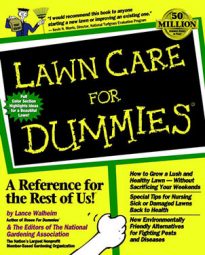You must use lawn herbicides carefully. Most of these products kill desirable plants as well as weeds. For example, tree roots and shrubs growing near the lawn can absorb some herbicides, such as dicamba (a systemic herbicide effective against broadleafed weeds). The dicamba can kill the trees and shrubs just as effectively as the weeds.
Always follow instructions on product labels exactly, making sure that the package label lists the weed you’re trying to control. (If you’re unsure which weed you have, take a sample to a local garden center or cooperative extension office for identification.)
If you’re using a dry herbicide applied by a drop spreader, make sure that your spreader is properly calibrated and adjusted. Avoid spraying on windy days, when herbicide drift may fall on desirable plants. When using ready-to-use liquid herbicides, make sure that the sprayer is off or points toward the lawn when you turn on the water.
Always follow product directions, especially when it comes to your own safety. If the label says to wear a mask, do it. If it says to wear gloves, wear them. Take all necessary precautions to keep the herbicide off of you.
Other tips on using herbicides:
If all your lawn needs is fertilizer, don’t apply a weed-and-feed product just because you have some around. Conversely, if you just fertilized, don’t follow up with a weed-and-feed product to control weeds. Ask your garden center or local cooperative extension office to recommend an individually packaged herbicide to control the weeds. In general, don’t apply anything to your lawn unless you’re sure the lawn needs it.
If weeds are a problem in only part of the lawn, treat that area separately. Spot-treating really troublesome patches with a nonselective, systemic herbicide such as glyphosate is sometimes the only way to get rid of the weeds. The nonselective herbicide kills all the lawn grass, as well as the weeds, so you need to patch the spot after everything dies. Sounds drastic, but this is sometimes the most effective approach.
Watering-in the fertilizer is important if you’re using a water-soluble fertilizer, such as ammonium sulfate, calcium nitrate, and others. Sometimes, and particularly with weed-and-feed products and dry herbicides, it is important not to water the lawn for at least 24 to 48 hours after application.

